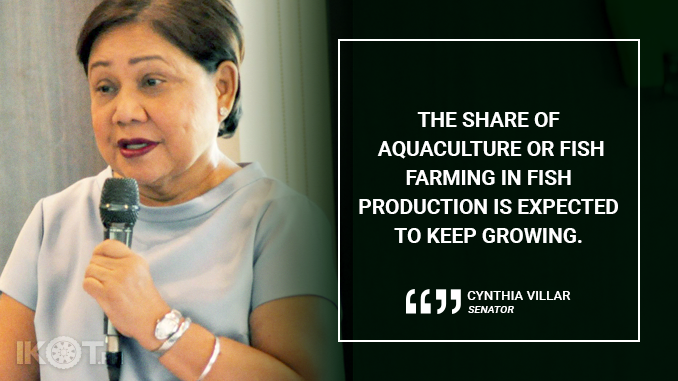Senator Cynthia Villar calls for more people involvement in the rapidly growing fish farming industry as she underscores the significant role it will play in the country’s long-term food security goals.
“Aquaculture is the future. It will feed us, especially kapag nagkatotoo ang warning ng experts na by 2050 ay baka virtual deserts na ang ating mga oceans. In the years ahead, lalo pang lalaki ang share ng aquaculture o fish farming sa fish production,’ said Villar, who is the chairperson of the Senate Committee on Food and Agriculture.
The veteran legislator urged fisherfolks, farm owners and enthusiasts, and cooperative members to take advantage of the budding enterprise, noting that the country’s aquaculture production is now estimated to be worth over $1.58 billion.
“Napakalaki talaga ng potensyal ng pagnenegosyo at pagiging involved sa aquaculture,” the seasoned lawmaker stressed.
The lady senator made the remarks at the closing of a 10-day training program on freshwater aquaculture sponsored by the Villar SIPAG in partnership with the Bureau of Fisheries and Aquatic Resources (BFAR), which was held at the Vintahanan floating village in Muntinlupa.
“Very timely ang kaalaman na natutunan ninyo sa aquaculture. I hope what you have learned in terms of new strategies, skills and systems through hands-on training will help improve your way of life by providing you with another source of income. I also hope that it will help farm owners and other farming enthusiasts to expand their businesses,” she said.
Aside from basic freshwater aquaculture, the 30 participants from the Calabarzon and National Capital Region also had hands-on training Post-Harvest techniques, Ornamental Fish Production, Aquaponics, and Basic Aquascaping.
“Mga kapaki-pakinabang ang mga kaalaman na itinuro sa inyo, lalong-lalo na in terms of technological innovation and technical expertise. Malaki ang maitutulong ng mga ‘yan sa inyo kung inyong i-a-apply at gagamitin ng maayos,” Villar added.
The Vinatahan floating village, which is venue for the training program, was conceptualized in July 2015. The floating houses are designed to float when floodwaters rise.

